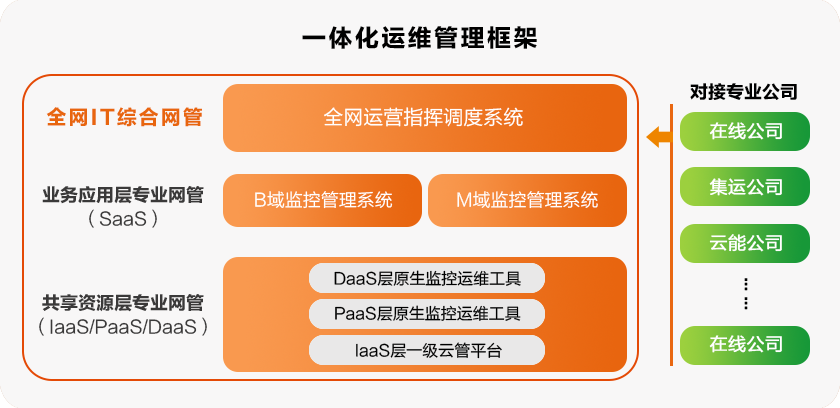Recently, AsiaInfo cooperated with China Mobile Information Technology Co., Ltd. (hereinafter referred to as: China Mobile Information) to launch the network-wide edge computing technical architecture for IT integrated network management in order to promote the development of 5G services, improve the “CHBN” market support, utilize new technologies to deepen IT system reforms, and improve the network-wide operations capabilities under new networks and new service environments. AsiaInfo has become the first batch of partners of China Mobile Information to apply the concepts and technologies of edge computing to actual services.

Edge computing technical architecture helps China Mobile’s core IT system service achieve a leap of quality
The “Network-Wide IT Integrated Network Management System” undertaken by AsiaInfo is at the core of “Network-wide IT System Integrated Operations Management Framework” of China Mobile. With explosive massive data access, cross-regional data integration, network-wide resource scheduling, agile calculation and support of complicated services, business alarms and processing, etc., it will perform the function of “operations command and dispatch center” in the IT field for the entire group in the future.
At present, the system has established an efficient architecture under the coordination of multi-party including group, provincial companies and professional companies. It is responsible for the management and monitoring of key services of all B and M domains of IT service departments, 31 provincial companies, professional companies and overseas institutions; it embeds command and dispatch capabilities into all links of the production process, realizing centralized monitoring of service quality in multiple scenes, a unified view of the entire network, collaborative resource scheduling, fault handling and unified evaluation, which will greatly improve the refined operations service level of IT systems for services and customers of entire China Mobile Group.

After the launch of edge computing architecture, the network-wide IT integrated network management and the network-wide service monitoring system based on customer perception have gained an end-to-end lean operations capability, with the overall system performance being improved by nearly 10 times, which effectively solves the weaknesses such as inadequate performance support in massive data analysis scene in operations management domain across 5 largest data centers in China.
AsiaInfo builds an edge computing architecture system for China Mobile to enable large-scale quality improvement and speed increase of “carrier-grade” services
Different from conventional enterprise services, the requirements for “uninterrupted operation, large capacity, stability, reliability” of “carrier-grade” services of operators are a complete dimension upgrade in terms of magnitude compared to other enterprises. It is conceivable that supporting network-wide communication services will be extremely difficult. At the beginning of designing the edge computing architecture mentioned above, AsiaInfo and China Mobile not only foresaw the large volume and complexity of 5G service in the future, but also attached great importance to efficiency improvement and cost optimization, in order to solve two major problems of “reducing the cost of data flow” and “flexible and elastic computing across nodes” with diligent care:
1. The cost of massive data flow remains to be reduced
The concurrence and aggregation of massive data from multiple centers often result in a backlog of data stacks. Thus, network delays and pressure on capacity and bandwidth of IT system will occur and intensify over time if not solved in a timely manner, which leads to increased data flow costs.
2. How does cross-node computing become elastic and flexible
Compared with traditional computing model, edge computing is closer to the user side and data source. The data undergoes the computing processing and application at the edge node without passing through the central server, which greatly shortens the service response time and optimizes the user experience. However, to achieve this goal in such a large and complex network-wide environment of communication operators, the flexibility and elasticity of cross-node computing must be satisfied first to realize the adaptive and lightweight communication of the “heartbeat protocol” between nodes.
AsiaInfo’s cross-center architecture solution for edge computing integrates “universal data collection and preprocessing” and “alarm service” into a front independent package, forming a “decentralized” IT technology architecture of unified rule algorithm management, independent collection and calculation, and independent alarm. Its highlights are mainly reflected in two aspects:
Highlight 1: Edging data processing to reduce transmission pressure
The data collection part of edge computing adopts an in-place deployment solution close to the data source, and uses distributed file storage technology with better performance for immediate access. In-place deployment greatly shortens the transmission link and reduces network consumption, making data collection and processing faster and more stable.
Highlight 2: Unified and agile multi-center management and extended deployment
The edge computing of centers in multiple regions is uniformly controlled through the network-wide service center, which adopts short message method to push the full content of business rules to the edges of multiple regions after the rules are modified in the center. In addition, the rapid deployment method of containerized packaging is adopted to provide rapid and stable deployment capabilities for new edge nodes.
Based on the above ideas, AsiaInfo cooperated with China Mobile to build an integrated operations management framework of network-wide IT system for China Mobile’s operation management domain, laying a good foundation of agile operations and management in order to promote large-scale “carrier-grade” services under the 5G environment in the future.





